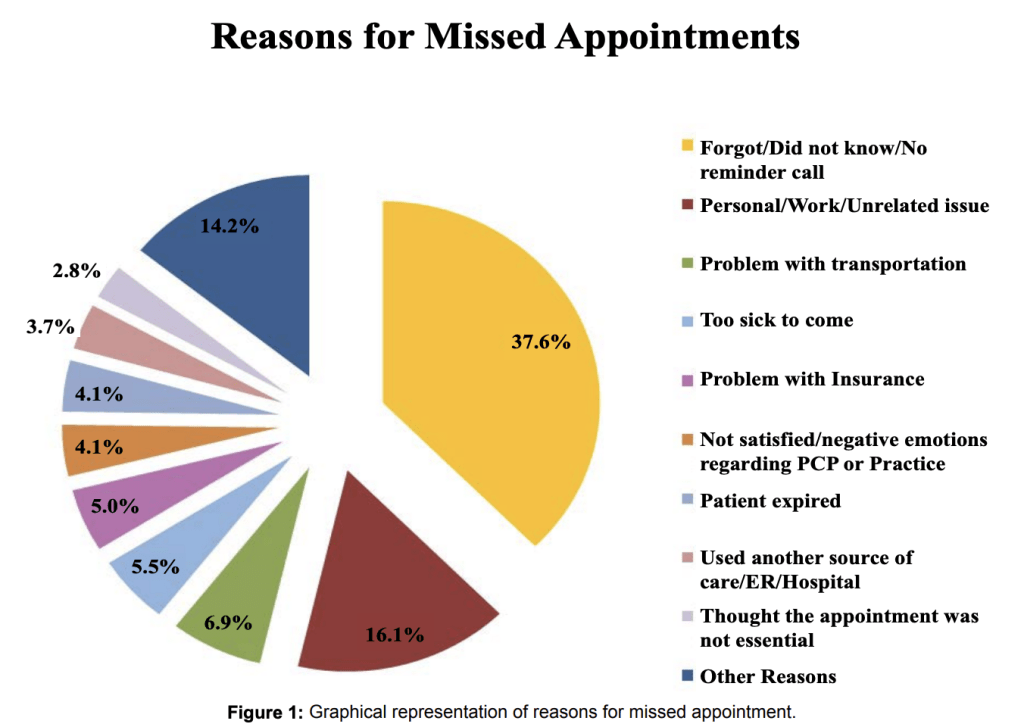

Nick Shaw
Nick Shaw has been Chief Revenue Officer (CRO) of Brightpearl, the number one retail-focused digital operations platform which encompasses sales and inventory management software, accounting, logistics, CRM, and more.
The day’s looking good. You look in the appointment book, know you’ve got a customer coming in so you can prepare for their arrival and optimise the session so you’re fully focused on your client, and turning the encounter into more business to mutual satisfaction. A world without booking would be a far trickier place for business to thrive in. You can see why booking caught on. Online booking especially is an absolute must for most businesses. But, get this:

It’s not just first-time appointments that can be unreliable. So, what happens when somebody gives you a last minute appointment cancellation? Time wasted. Just think of what you could have done with the session and preparation time: generated other business, caught up with some admin or just had some you-time. No, don’t think about it anymore. Instead, turn your attention to what you can do the next time somebody cancels on you.
It’s easy to give advice that tells you what you should have done in the first place. By the time a business is affected by a cancellation it’s too late for that. Let’s start with what you can do the moment you get a cancellation.
1. Shout about a bonus spot
So, all of a sudden you have personal appointments available. Let’s see this as a positive. Out of the blue, you can offer an appointment book resource to somebody who wasn’t expecting it. One way to get appointment opportunities out there is via social media. Or you may have an email list. Or you can stick appointment times available on your website. If you have an online last minute appointment booking system, then this route can work very well.
Happily, with the widespread uptake of remote meeting technology, very last-minute sessions are a much more practical proposition than they once were.
Walk-in days are a possibility too. If you have an extended free period because of a series of appointment gaps, a day where you make limited appointments available to impulse customers can be very rewarding.
But what can you do to prevent cancellations in the first place?
2. Cancellation policy
Any company, whether a tiny one doing a couple of sales a day, or a massive one engaged in bigcommerce order management, will benefit from the creation of a clear set of conditions that are communicated to the client before or at the time of booking. These conditions delineate what is and what is not acceptable in terms of varying or canceling the booking arrangement.
What needs to be in this policy?
Timeframe

How much time would you need to have a good chance of filling the slot with an alternative productive session? A great many organisations insist on a 24 hour embargo. There’s no reason why you can’t insist on more, if that’s what you think you need. Don’t worry about the impression this might make. If anything, you will come across as a more precious commodity, much in demand and consequently not the kind of resource that a customer is likely to toy with.
Penalty
Decide on a penalty for late cancellation. Something like an admin charge is perfectly acceptable. You may wish to waive this penalty for certain circumstances. A tragedy is clearly something you will not want to be too strict over. Similarly, some businesses extend a bit more leniency to customers who have demonstrated loyalty over time.
Contact information
Ensure that your customer has effective contact information for you so that if a cancellation does have to be effected, you know about the whole thing as soon as possible.
Transparency
Finally, make sure that all this is plainly visible, on the website for instance, together with any correspondence you enter into when arranging the meeting, especially the contract. That way the client cannot claim to be ignorant of the conditions.
3. Reminders
There are lots of reasons people cancel or miss appointments.

People are busy. That’s fine. We all understand that. A way to accommodate this is to send out a reminder. This has the added benefit of showing that you understand how busy the client is.
Best practice for this is a matter for debate. Some prefer emails. Some favor an SMS approach. What you probably want to avoid is overkill, so choose a method and stick to it. Perhaps you will have asked for contact preference when you harvested the client’s contact details in the first place.
The reminder should obviously carry time and date details, as well as a reminder of your contact details and, naturally, that cancellation policy. The really good news about all this is that you don’t need to sit there slavishly typing out reminders for each customer. It’s simplicity itself to automate the reminder process and there are great packages out there to help you.
4. Simplify rescheduling
From time to time, a rearrangement becomes necessary. If a customer has to rearrange the time slot, it is hugely important to make sure that the tools they need to complete that process are easy to use and highly visible. If a customer cannot easily see how to change a booking, they may commit the offense we’re all trying to avoid, ie, a last-minute cancellation, or just not show up.
The best way to extend an easy to use facility is probably to give the customer the ability to change their booking on your website. Obviously, you will want to apply a timeframe aspect to any last minute appointment alterations, as with the cancellation policy. But the name of the game is retaining the customer so do try to be as flexible as you think your business can be.
5. Deposits

This means that you ask for your fee (or part of your fee) to be paid at the time of booking.
Some companies are reluctant to apply this, but look at it from the customer’s perspective. If they feel that you are casual enough to devote a chunk of your time to a promised future encounter, with no guarantee that it will actually happen, they may well conclude that you don’t value your time that highly. In consequence, they may agree.
By applying an up-front value to the arrangement, you are underlining the gravity of the situation. You are encouraging the customer to take the liaison seriously. The customer is then more likely to apply themselves to the arrangement, not seek to rearrange needlessly and be less likely to forget about the whole thing.
Another advantage to this approach is the assistance it gives to your ERP system inventory management. When it comes to resource planning, having the money in place is always advantageous.
A variation on this is to offer appointment packages of several bookings that the customer can buy in advance.
Big caveat: be careful about the local regulations that apply where you operate. In some states, you are prohibited from asking for a sizeable downpayment, whether for a single session or an appointment package. In other states, it is definitely frowned upon.
6. Waiting lists
These are invaluable. The next time you have a last minute appointment cancellation, you can simply turn to your list of eager potential alternatives and pluck yourself a replacement. OK, it may not be that simple some of the time, but the benefits of having a list of people wanting to be contacted in this situation are not to be trivialized.
It’s also great PR. If you’re a customer wanting to access a company’s services but it turns out they’re so successful that they can’t squeeze you in when you most want, you’ll be thinking that they’re an outfit to be taken seriously. If they then demonstrate a wish to accommodate you, if at all possible by using a waiting list, then you have the perfect marriage of a successful profile and customer care.
7. Lose the chaff
There is nothing wrong with being a little picky. If a customer is a repeat offender in the cancellation game, or even if they repeatedly fail to make an appointment on time, then consider declining any more bookings with them. Explain to them the situation, apply a remedial time period, and one of two things will happen.
One, they will disappear from your life. This is to be avoided if possible, but in terms of disasters, there is worse that can be envisaged than the loss of a problematic and expensive customer.
Two, they will take on board how their behaviour has impacted you and your business. Sometimes it takes making consequences visible to encourage a behaviour change. Obviously, you will want to be careful how you apply this approach. If the customer has canceled on you in a manner that doesn’t impact too much on your costs, like online shopping cart abandonment for instance, then you won’t want to come down too heavily on them. A simple offer of assistance can work here.
8. Keep the wheat
The corollary to the chaff chopping is the wheat wooing. There are great reasons for treating customers well, which means improving the customer experience.

The important factor to bear in mind here is that the more you give outstanding customer care, the better they will treat you. It sounds simplistic, but it’s also true. Consider the ways to make your customer feel like the most special customer in the world.
These might include using your customer database to enable sending out birthday emails with special offers. Or just making sure that you always respond rapidly and civilly to any client communication, including last minute appointment requests, for instance.
Conclusion
So, there you have it. One tip on what to do when somebody has canceled, and seven ways to try to ensure it doesn’t happen in the first place. Humans and events are unpredictable and difficult situations can emerge. But with the right approaches in place you can seek to mitigate this. At least a little.

About the author
Nick Shaw
Nick Shaw has been Chief Revenue Officer (CRO) of Brightpearl, the number one retail-focused digital operations platform which encompasses sales and inventory management software, accounting, logistics, CRM, and more, since July 2019 and is responsible for EMEA Sales, Global Marketing and Alliances. Before joining Brightpearl, Nick was GM and Vice President of the EMEA Consumer business at Symantec and was responsible for a $500m revenue business. Nick has written for sites such as Hubspot and G2. Here is Nick Shaw’s LinkedIn.
Related articles


